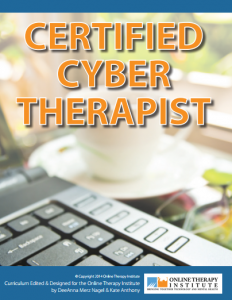 Editor’s note: Welcome to Cedric as our new CyberSupervision columnist! Here, we welcome him with a feature article introducing his methods and approach.
Editor’s note: Welcome to Cedric as our new CyberSupervision columnist! Here, we welcome him with a feature article introducing his methods and approach.
“Words can sometimes, in moments of grace, attain the quality of deeds.” – Elie Wiesel
“I usually focus on client strengths from the beginning of the correspondence, as well as touching upon inner and outer resources to help the client deal with their life predicament. We go through some reframing and explore solution-focused perspectives. Yet it all begins with the joining and the feeling of ‘I am with you… I sense your pain and struggle… yet I perceive something else about you… let’s walk through this together.” – Dr. John Yaphe, E-Counsellor
“I feel as if someone has put an arm over my shoulder and is talking with me.” – E-Counseling client
Welcome to the first installment of a new series of TILT supervision columns. First of all, I would like to pay tribute to my predecessor Anne Stokes, for the quality, dedication, and consistency she brought to this column. As the mantle is passed to me with guest appearances by my co-supervisor Michele Mani, I would like to thank Anne for the foundation she laid. Of course, my voice and approach will be a different one. I won’t try to emulate Anne which would just make you, the reader, miss her all the more. I never could adjust to Piers Morgan replacing Larry King, and hope the analogy doesn’t hold 😉 So subsequent to this introduction, I will be offering generic examples and excerpts from online supervision demonstrating the best practices we have discovered over 15 years and counting… while guiding E-counsellors along the path to E-mastery, as I like to call it.
In the spring of 2000, I was parachuted into (hired by) a major EAP company to be the pioneer of online counselling in an EAP setting in Canada. It was still relatively uncharted territory at that time, yet equipped with a narrative perspective, short-term solution-oriented methods, and a love of letter-writing (asynchronous modality), I found a new ‘path and practice’ unfolding. These many years later, the anecdotal evidence of our success remains inspiring. Here is a typical example of what our clients have experienced.
“I have to admit that I was a bit skeptical at first. At the time I couldn’t see how this was possible and worried that this was another pop psychology answer to our instant oatmeal society. But I decided I didn’t have anything to lose. I was able to share thoughts and feelings that I know I wouldn’t have dared to express in a face-to-face session. I had no idea it was possible to form a bond and a trust with someone based solely on the written word. Thoughts and feelings just seemed to flow out of me in a way I never could have imagined. It was really like writing to an old friend… a really wise friend who knows when to challenge you and when to support you. I find myself missing his words and thoughts. Thankfully, I have past correspondences to rely upon. I was apprehensive about trying E-counselling but find it was the best move I ever made.” – E-counselling client
Yet in December, 2007, the following letter to the editor appeared in The Toronto Star in response to a feature article about the success of our online service.
“I must admit that the whole concept of e-therapy makes me uneasy. If a patient is writing about his/her issues online, he/she can easily omit certain thoughts or feelings. Furthermore, the therapist does not have the advantage of examining body language and tone of voice as the individual speaks. E-therapy might be part of a harm reduction strategy for those who flat out refuse to see a therapist face-to-face, but it’s not without risks. In general, it is much easier to distort the written word. Add mental illness to the mix, and you have a potentially dangerous situation.”
Yes, of course there are risks and we instituted a reliable risk management process according to the ethics of e-therapy. There is also professional due diligence for any “potentially dangerous situation”. Yet there is also ample evidence of the quality of therapeutic alliance available online. The act of getting it down in writing, seeing it in print, or composing oneself is of great therapeutic benefit in itself. What might be lost from the immediate give-and-take of ‘live’ conversation can become a gain. The process is slowed down and with clients not ‘on the spot’, they have all the advantages of an introspective process that is still part of a therapeutic dialogue – a dialogue that takes place behind the scenes of appearance and personality in a shared space mediated by the third focus – the text itself. Both insight and catharsis are possible in the safest of environments as a window is opened to the thought and feeling processes on both sides of the computer. The text-based bonding that results includes the experience of tele-presence, non-local presence, or the feeling of persons being next to each other, even at a physical distance. When this occurs in online counselling, clients routinely use the language of face-to-face encounters, e.g. “It has been really great talking to you.” Yet it’s more than talking. The text itself, the transcript of the correspondence, becomes a ‘transitional object’ facilitating self-compassion as the client internalizes the voice of the counsellor. Overall, the medium lends itself to a combination of intimacy and distance, a clinical parallel to the discovery of balance between belonging and autonomy that is a theme common to many cases.
The clients always express it best, and underlying the simplicity of the following comment is the depth of what the client means by “literally”. “Thank you for the beautiful e-mail. It literally touched me. I can feel how supportive you are just in one exchange of words – that’s what I want in a psychologist, and haven’t been able to find.”
I’ve summarized the primary process because I view E-Counselling not just as a transfer of therapeutic skills to a different medium but as a new field of practice. This perspective naturally has an impact on the secondary process, namely E-Supervision. There’s a steep learning curve involved in developing the kind of text-based sensibility it takes for otherwise superb practitioners to transfer their talents to this medium. Those already working with us have showed the most promise in that direction. However they have all been subsequently surprised by what it takes in the challenging transition from the traditional ‘talking cure’ to the ‘writing cure’.
As E-Counselling intake volume increased, so did the ‘E-team’ of E-counsellors. Due to the specialized skills needed, as well as the heightened accountability and liability associated with written transcripts of online sessions, special attention was given to the recruitment, orientation and training of the E-team. When the service was launched and its credibility and safety had not yet been established, every case was closely monitored for quality assurance. Yet in keeping with developmental models of supervision, our program encouraged the evolving phases of increased counsellor autonomy. One of the constants to this day, however, has been that ‘hands-on’ supervision is always available and has the unique advantage of taking place mid-session. Counsellors can consult after the client has posted a message and before they respond. We’ve created a structure of accountability that still applies and takes the form of three occasions for supervisory interventions: (a) clinically challenging cases needing supervisory support at intake and/or mid-case; (b) post-closure case review to refine online methods and consider different text-based approaches in the light of client feedback; (c) counsellor management support for modality specific procedures, protocols, policies and best practices.
Case consultation can take place whenever an E-counsellor feels stuck, frustrated, unequipped or simply needing support on how to apply best practices to a particular case. Counsellors use case consults for immediate case management strategies as well as ongoing professional development. We take these opportunities to enhance typical skill sets specific to the modality: the need to pay close attention to the client’s text; intuitive assessment without overdoing diagnostic questioning; practicing client-friendly language and ‘voice’; maintaining a consistent online framework and parameters; reading between the lines for what is absent yet implicit in the text, i.e. what clients are not saying; mastering the nuances of tele-presence and feeling tone online, and leading the process without becoming didactic or falling back on psychoeducation which can take on a ‘counselling correct’ or pre-set ‘canned’ effect ( Yaphe & Speyer, 2010).
With that professional ‘back story’, here is a preview of things to come in this column as we open a supervisor’s guidebook to TILT readers. In training online novices, I always impress upon them that there are three ways of writing to a client. The first and least conducive to text-based bonding is when we write at the presenting problem with informed commentary on the nature of the issue (this is when clients might complain that they could gain the same from a textbook or self-help article). The second level of therapeutic writing is when we write to the issue, focusing mainly on the content of the client’s reported life situation, while investigating possible coping methods and potential therapeutic goals (this is when the online exchange might sound like an advice column, consultation, or coaching session). The third and most advanced approach to creating the online alliance is when we are writing with the person behind the problem. We then position ourselves as co-authors of a bigger story in which the client can discover their growing edge under the circumstances or have a heroic role to play in what is first described as an intolerable life situation. We accomplish this by entering a shared narrative space from our side of the computer, where healing can take place as a result of an expanding point of view; when the client’s story and the E-Counsellor’s layered reading of it leads to a creative synergy producing new possibilities. We call it being in the zone and we know it from the energetic joining which is mutually felt, as if the client is in the room with you, and together you are exploring life-giving directions at the crossroads of their present predicament.
REFERENCE
Yaphe, J. & Speyer, C., 2010. Using email to enrich counsellor training and supervision in Anthony, K., Nagel, D.M. & Goss, S. (Eds.). The Use of Technology in Mental Health: Applications, Ethics and Practice; Springfield IL; Charles C. Thomas, Publisher.
Cedric Speyer is Clinical Supervisor of E-Counselling for Morneau Shepell. As founder and pioneer of the Shepell E-Counselling service, he developed and implemented a short-term counselling model for online practitioners, edited the main textbook on the subject, and continues to engage in related writing and publishing, while serving as an e-therapy mentor.
This article first appeared in the Winter 2015 issue of TILT Magazine ~ Therapeutic Innovations in Light of Technology.
Click here to read the entire PDF version: Pathways to E-Mastery: A Supervisor’s Guidebook


